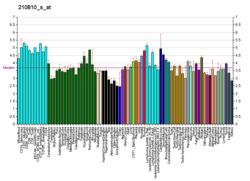Glycine transporter 2
Glycine transporter 2 (GlyT2) also known as the sodium- and chloride-dependent glycine transporter 2 or solute carrier family 6 member 5 is a protein that in humans is encoded by the SLC6A5 gene.[5]
The glycine transporter 2 is a membrane protein which recaptures glycine, a major inhibitory transmitter in the spinal cord and brainstem. GlyT2 is a specific marker of glycinergic neurons and a member of the Na+ and Cl−-coupled transporter family SLC6. Glycine uptake mediated by GlyT2 is electrogenic, coupled to three Na+ and one Cl− (i.e. two positive charges per glycine). In humans, GlyT2 is encoded by the SLC6A5 gene. Inactivation of GlyT2 in knockout mice is lethal during the second post-natal week as the absence of GlyT2 disrupts inhibitory transmission by reducing glycine release. Mutations in SLC6A5 gene are responsible for a presynaptic form of hyperekplexia, a genetic disease causing increased startle reflex. GlyT2 main physiological role is to recapture glycine released in the synaptic cleft and to maintain high glycine concentration in the presynaptic neuron. Therefore, chronic inhibition of GlyT2 will deplete intracellular storage of glycine and limit its accumulation in synaptic vesicles.[5][6]
Inhibitors
- Amoxapine
- Ethanol
- N-Arachidonylglycine (NAGly)
- Opiranserin (VVZ-149)
- ORG-25543
- VVZ-368
See also
References
- 1 2 3 GRCh38: Ensembl release 89: ENSG00000165970 - Ensembl, May 2017
- 1 2 3 GRCm38: Ensembl release 89: ENSMUSG00000039728 - Ensembl, May 2017
- ↑ "Human PubMed Reference:".
- ↑ "Mouse PubMed Reference:".
- 1 2 Morrow JA, Collie IT, Dunbar DR, Walker GB, Shahid M, Hill DR (November 1998). "Molecular cloning and functional expression of the human glycine transporter GlyT2 and chromosomal localisation of the gene in the human genome". FEBS Lett. 439 (3): 334–40. doi:10.1016/S0014-5793(98)01390-8. PMID 9845349.
- ↑ "Entrez Gene: SLC6A5 solute carrier family 6 (neurotransmitter transporter, glycine), member 5".
Further reading
- López-Corcuera B, Aragón C, Geerlings A (2002). "Regulation of glycine transporters". Biochem. Soc. Trans. 29 (Pt 6): 742–5. doi:10.1042/BST0290742. PMID 11709067.
- Gallagher MJ, Burgess LH, Brunden KR (1999). "Characterization of multiple forms of the human glycine transporter type-2". Brain Res. Mol. Brain Res. 70 (1): 101–15. doi:10.1016/S0169-328X(99)00135-7. PMID 10381548.
- Evans J, Herdon H, Cairns W, et al. (2000). "Cloning, functional characterisation and population analysis of a variant form of the human glycine type 2 transporter". FEBS Lett. 463 (3): 301–6. doi:10.1016/S0014-5793(99)01636-1. PMID 10606742.
- Martínez-Maza R, Poyatos I, López-Corcuera B, et al. (2001). "The role of N-glycosylation in transport to the plasma membrane and sorting of the neuronal glycine transporter GLYT2". J. Biol. Chem. 276 (3): 2168–73. doi:10.1074/jbc.M006774200. PMID 11036075.
- Geerlings A, Núñez E, Rodenstein L, et al. (2002). "Glycine transporter isoforms show differential subcellular localization in PC12 cells". J. Neurochem. 82 (1): 58–65. doi:10.1046/j.1471-4159.2002.00930.x. PMID 12091465.
- Baliova M, Betz H, Jursky F (2004). "Calpain-mediated proteolytic cleavage of the neuronal glycine transporter, GlyT2". J. Neurochem. 88 (1): 227–32. doi:10.1046/j.1471-4159.2003.02192.x. PMID 14675166.
- Jamra RA, Villela AW, Klein K, et al. (2006). "No association between genetic variants at the GLYT2 gene and bipolar affective disorder and schizophrenia". Psychiatr. Genet. 16 (3): 91. doi:10.1097/01.ypg.0000199450.07786.ab. PMID 16691125.
- Rees MI, Harvey K, Pearce BR, et al. (2006). "Mutations in the gene encoding GlyT2 (SLC6A5) define a presynaptic component of human startle disease". Nat. Genet. 38 (7): 801–6. doi:10.1038/ng1814. PMC 3204411. PMID 16751771.
- Roux M, Supplisson S (2000). "Neuronal and glial glycine transporters have different stoichiometries". Neuron. 25 (2): 373–83. doi:10.1016/s0896-6273(00)80901-0. PMID 10719892.
- Aubrey K, Rossi FM, et al. (2007). "The transporters GlyT2 and VIAAT cooperate to determine the vesicular glycinergic phenotype". J. Neurosci. 27 (23): 6273–81. doi:10.1523/JNEUROSCI.1024-07.2007. PMID 17554001.
- Rousseau F, Aubrey KR, Supplisson S (2008). "The glycine transporter GlyT2 controls the dynamics of synaptic vesicle refilling in inhibitory spinal cord neurons.". J. Neurosci. 28 (39): 9755–68. doi:10.1523/JNEUROSCI.0509-08.2008. PMID 18815261.
- Eulenburg V, Becker K, Gomeza J, et al. (2006). "Mutations within the human GLYT2 (SLC6A5) gene associated with hyperekplexia". Biochem. Biophys. Res. Commun. 348 (2): 400–5. doi:10.1016/j.bbrc.2006.07.080. PMID 16884688.




